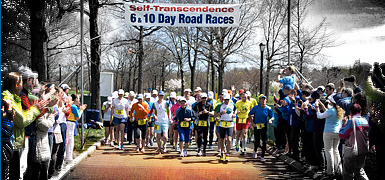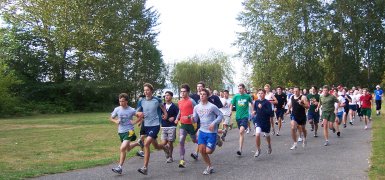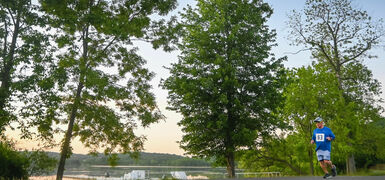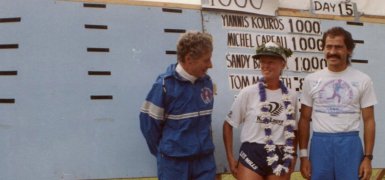Milroy, Andy. "The History of the 1,000 Mile Race." 1989. Ultrarunning. Printed with permission from the publisher.
"It is in the nature of the ultra marathoner runner to seek new challenges. In recent years the ambition of many runners became to tackle a six-day race. Veterans of such races have now moved on to face perhaps the ultimate standard event: the 1,000 mile race. This event has a pedigree stretching back at least two hundred years, making the six day race look a more upstart in comparison.
The earliest 1,000 miler that I have discovered was put on in Birmingham, England, in the depths of the winter of 1758. The local pedestrian or professional walker, George Guest, wagered that he could cover 1,000 miles in 28 days. He finished his walk in February, 1758, with five hours to spare, covering six miles in the last hour.
Fifty years later, in the heyday of pedestrianism in the time of the Napoleonic Wars, such 1,000 mile matches were commonplace. Pedestrians like Stokes, Jones, Eaton, Crisp, and Wilson specialized in doing 1,000 miles in 20 days. However, it was the last two, Daniel Crisp and George Wilson, who were to improve on the average of 50 miles a day.
George Wilson, in 1815, was involved in one of the most controversial incidents in sport in the early nineteenth century. Whilst in the middle of one of his 20 day/1,000 mile wagers at Blackhearth, he was stopped by the police and charged with causing a public disturbance. He lost the bet and the subsequent court case. In debtor’s prison, Wilson, a pedestrian to the last, walked 50 miles in 12 hours in a small 11 yard by 8 yard area, making 9.026 turns.
This was not the end of Wilson’s 1,000 mile efforts. In November, 1816, he covered the distance in 17 days, 23 hours, 19 minutes, 10 seconds at Hull. The following year Daniel Crisp walked 1,134 miles in 21 days on the Uxbridge road, drawing an audience of some 10,000 people. And a year later on the same road, he completed 1,037 miles in 16 days, 23 hours, and 8 minutes, despite floods. The Thames River overflowed its banks onto the road during his walk, and five times he had to wade through a quarter of a mile of water.
Crisp’s mark stood for some sixty years until the American Edward Payton Weston came to Britain. Weston is well known as the pioneer of the six day race, but he undertook a variety of wagers in his various trips to Britain. As well as five day matches, 1,500 mile and 5,000 mile walks, he also agreed to walk 1,000 miles in 400 consecutive hours. This feat took place at the Northumberland Cricket Ground, Newcastle-Upon-Tyne, in 1877, and was competed in 16 days, 15 hours, 41 minutes. Weston didn’t walk on the two intervening Sundays and altogether took 150 hours, 38 ½ minutes rest.
The nineteenth century was also renowned for another type of athletic contest, known as the Barclay Match. The reason for the title is that this type of endurance feat was popularized by Captain Robert Barclay. In October, 1808, he made a match with Mr. Wedderburn Webster for one thousand guineas to walk 1,000 miles in 1,000 consecutive hours. This may not seem a very arduous undertaking, but there was one condition that made it very difficult – Barclay had to walk one mile in each and every hour. Several famous pedestrians had attempted this exploit only to be defeated not only by the distance and the exertion, but also by the lack of sleep and rest which forced them to retire with swollen legs and loss of weight.
Captain Barclay started the walk on June 1, 1809, on Newmarket Heath. The first eleven or twelve days went without problems, but he began to get pains in his legs on the thirteenth day, slight at first but gradually worsening. These pains were augmented on the twenty-third day by toothache and by the twenty-sixth day he was very ill and stiff. He found great difficulty in walking, and complained much about the pain. By the thirty-second day he could rise after resting only with help, and he needed so much time to complete the walk he had little opportunity to rest. Two days later he could not move without crying out and ‘walked in a shuffling manner’. By the thirty-fifth day such was his fatigue and agony that it was thought it was probably impossible for him to continue. ‘The spasmodic affections in his legs were particularly distressing.’
By the forth-first day (1,000 hours equals 41 days and 16 hours) it was clear that he couldn’t continue much longer. Fortunately his ordeal was to end the following day. A huge crowd was at the finish to see him successfully complete the one-thousandth mile in the one-thousandth hour. The crowd was so large that it was necessary to rope off the ground, and several pugilists who had been supported by Barclay in their fights assisted to keep off roughs. His first mile had taken him 12 minutes, his last took 22. He lost over 35 pounds in weight, but won 16,000 pounds in wagers (which would be getting on for a quarter of a million in today’s currency). After the finish he had a bath, and then slept for 17 hours, after which he got up in perfect health, free from pain, and went for a long walk about Newmarket including four miles on the race course.
Barclay’s feat was copied by many pedestrians in the later years of the nineteenth century. Richard Manks walked one mile every half hour for one thousand miles. Peter van Ness did half a mile every half an hour for two thousand successive half hours, and William Gale did one and a half miles every hour for one thousand successive hours.
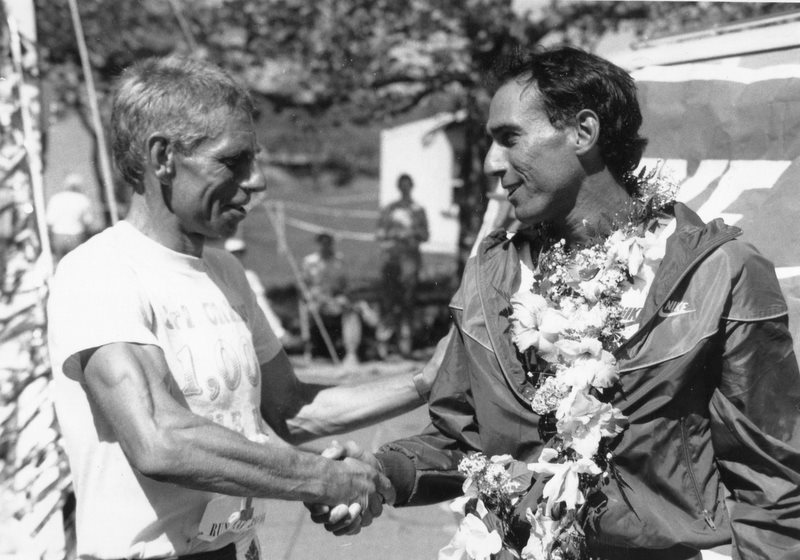 The record for the straight-forward 1,000 miles remained with
The record for the straight-forward 1,000 miles remained with
Edward Weston’s 16 days, 15 hours for the better part of a century, although several claims to have bettered it were made. Then in 1975 a unique race was set up in South Africa, a 1,000 mile race from Pretoria to Cape Town. Siegfried Bauer, a Czech who had become a naturalized New Zealander and who specialized in solo multiday journey runs, was invited. He faced John Ball, a runner with a similar athletic background. These two men battled it out all the way to the finish. By the end of the fifth day Ball led the New Zealander by about three and a half hours, but by the seventh day Bauer had taken the lead with a mere 340 miles to go. He kept the lead to the finish, despite a late race surge from the South African. Both men finished over three days inside Weston’s mark, with Bauer the new record holder in 12 days, 21 hours, 46 minutes, 30 seconds.
That was the last 1,000 mile race until November 1983, when the small Australian town of Colac entered the business of promoting international multi-day races. Colac is the hometown of Cliff Young, the remarkable 60 year old who, that year, had won the Sydney to Melbourne race in record time. Young had made an attempt on the 1,000 mile best the previous year in a solo run, but had to stop at 500 miles with a back injury.
The 1,000 mile race started from the Parliament steps in Melbourne. Then followed a 92.3 mile run to Colac and thereafter the race was around a 538.06 meter circuit in Memorial Square. The race was a battle between Siegfried Bauer and Tony Rafferty, who also had thousand mile credentials. Rafferty led for the first 600 miles, but was eventually forced to retire. Bauer, the only finisher, set a new world best of 12 days, plus 12:36:20.
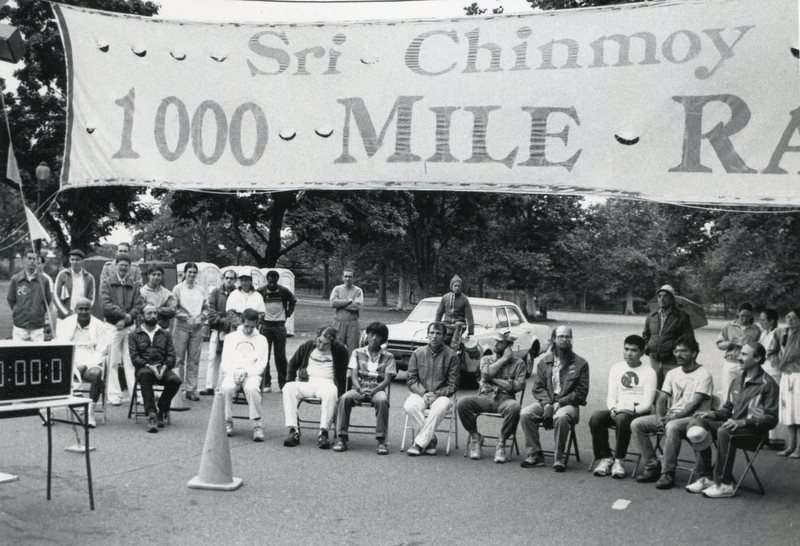
In 1985 the Sri Chinmoy Organization put on an open 1,000 mile race on a one mile certified course in Queens, New York. Three men finished, Don Choi in 15 days plus 6:24, closely followed by Trishul Cherns and Emil Laharrague.
The Sri Chinmoy race is an annual one. When held in late April of this year it attracted an experienced field. Bauer lined up for his third 1,000 miler and was the obvious favorite. But he had some tough opposition, including Stu Mittleman who has better marks in ultra events from 100 miles to six days. Choi and Cherns renewed their rivalry, and were joined by British six day veterans Alan Fairbrother and Dan Coffey.
By the end of the first day Bauer had a four mile lead over Mittleman, 120 to 116, and he continued to pour on the pace for the next three days, setting a new road best for 48 hours of 215 miles. After 6 days the New Zealander had a narrow lead over the New Yorker, 513 miles to 503, with Cherns solidly in third. On the seventh day, after an extended battle, Mittleman pulled out a two mile lead, and the following day really put the pressure on. Bauer, hampered by an ankle injury, was unable to respond. From day five to day ten, Mittleman covered 532 miles, the best six day distance so far this year.
Mittleman went on the break Bauer’s mark by 16 hours with a time of 11 days plus 20:36:50. Despite obvious problems, Bauer battled on to finish in 12 days, 22 hours, motivated by the fear of the slowly closing Trishul Cherns, who cut two days off his best with a 13 day, 7 hour time."

